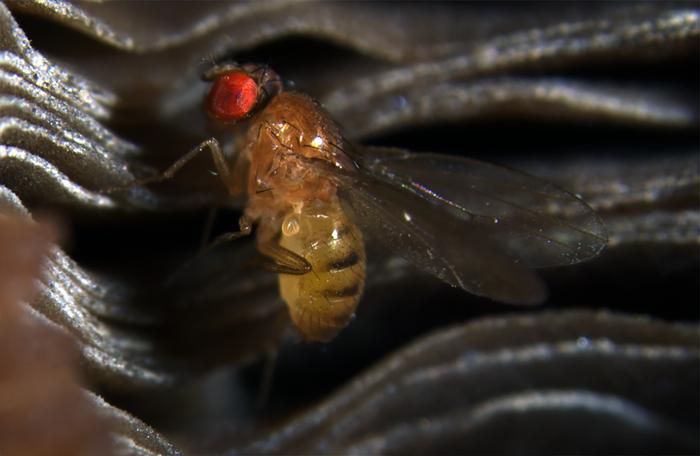
In a groundbreaking discovery that shatters traditional understandings of genetic inheritance, scientists at the University of British Columbia and the University of Victoria have identified a remarkable chromosome in the fruit fly species Drosophila testacea that cheats the rules of meiosis in both males and females. Unlike previously known selfish genetic elements that distort inheritance in only one sex, this selfish X chromosome manipulates the transmission of genetic material through sperm and eggs alike, revealing a sophisticated mechanism of genetic conflict that transcends conventional biological boundaries.
Chromosomes are the carriers of genetic information, meticulously ensuring the passage of DNA from parents to offspring during reproduction. In sexual organisms, meiosis divides germ cells to form haploid gametes — sperm and eggs — each ideally containing an equal chance for any given chromosome to be inherited. However, certain elements called meiotic drivers subvert this fairness by biasing their transmission to the next generation. The newly discovered selfish X chromosome in Drosophila testacea exhibits this cheating behavior with unprecedented dual-sex functionality.
According to lead author Graeme Keais, a PhD student at UBC, prior research on meiotic drive focused predominantly on genes that skew inheritance in males or females but never both simultaneously. “This is the first known instance of a selfish chromosome that successfully distorts inheritance in the gametes of both sexes,” he explains, emphasizing the profound implications for how we understand genomic conflict and inheritance.
The selfish X chromosome targets two distinct cellular environments — the testes and the ovaries — executing separate strategies to maximize its propagation. In male flies, it actively eliminates Y-bearing sperm, which would produce male offspring lacking this X chromosome. This selective destruction ensures that more sperm carry the selfish X, skewing the sex ratio in favor of female progeny. Remarkably, in female flies, the same X chromosome is preferentially included during the asymmetric cell division of eggs, further amplifying its presence across generations.
Dr. Steve Perlman, a biologist at the University of Victoria and senior researcher of the study published in the Proceedings of the National Academy of Sciences, underscores the biological ingenuity of this mechanism: “Hijacking meiosis in the radically different contexts of male germ cells and female oocytes demonstrates the astonishing adaptability of selfish genetic elements and highlights a new dimension in the evolutionary arms race within genomes.” This adaptability reflects a complex balance of genetic conflict that shapes genome architecture far beyond simple Mendelian inheritance.
A deeper dive into the genome reveals that this selfish X chromosome behaves as a supergene — a structurally unusual cluster of linked genes that do not recombine with their counterparts on the normal X chromosome. This lack of genetic mixing has allowed the selfish X to expand nearly twice the size of a typical X chromosome by accumulating repetitive DNA sequences. These structural peculiarities not only mark it physically distinct but also may play a direct role in enabling its ability to cheat during female meiosis.
The accumulation of repetitive DNA in non-recombining regions like supergenes may be more than a genomic quirk; it could foster the evolution of selfish behaviors by preserving beneficial gene combinations that orchestrate meiotic drive. This finding opens up new avenues for exploring how non-mixing genomic regions contribute to genetic conflict and evolutionary dynamics within species.
While meiotic drivers are known to influence population genetics dramatically, the discovery of one that functions through both sexes introduces fresh complexities. By biasing inheritance at multiple stages and across sexes, such selfish elements can profoundly affect sex ratios, reproductive success, and even species evolution. These distortions may have cascading effects, from altering mating systems to driving speciation.
The study employed rigorous observational methods to analyze genetic inheritance patterns in natural populations of Drosophila testacea, and molecular assays to characterize the structure and sequence content of the selfish X chromosome. These approaches enabled the researchers to elucidate the chromosome’s unique dual-sex meiotic drive mechanism with compelling clarity.
This research not only advances fundamental genetics but may also have potential implications in applied sciences. Understanding the mechanisms by which selfish chromosomes manipulate inheritance in both sexes could inform novel approaches in pest control or synthetic biology, where engineered meiotic drivers could be harnessed to influence population genetics deliberately.
Ultimately, these insights into Drosophila testacea illuminate a broader narrative of how genomes are arenas of intense conflict and cooperation. The selfish supergene exemplifies the intricate battles waged at the molecular level, reminding us that inheritance is far more dynamic and contested than traditionally assumed.
The discovery sparks a crucial reevaluation of models of genetic transmission and raises questions about the prevalence and diversity of such mechanisms across other species, potentially reshaping evolutionary theory and our understanding of genome biology.
Subject of Research: Animals
Article Title: A selfish supergene causes meiotic drive through both sexes in Drosophila
News Publication Date: 23-Apr-2025
Web References: 10.1073/pnas.2421185122
References: Proceedings of the National Academy of Sciences
Image Credits: MA Hanson
Keywords: Genes, Developmental genetics
Tags: biases in genetic transmissioncheating behavior in Drosophila testaceachromosome behavior in reproductiondual-sex genetic mechanismsevolutionary biology of fruit fliesgenetic inheritance in sexual organismsgenetic manipulation in meiosisgroundbreaking discoveries in geneticsimplications of selfish genetic elementsmeiotic drive and genetic conflictselfish X chromosome in fruit fliesUniversity of British Columbia research





